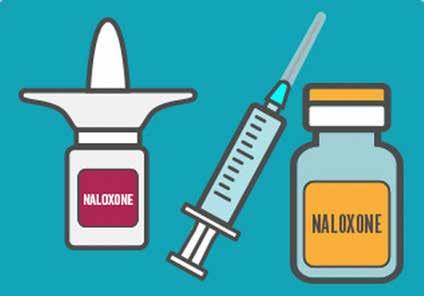
5 minute read
Naloxone Conversion to Over The Counter Status May Create a Financial Strain for Some Groups
Steven H. Linder MD & Members of The Santa Clara County Opioid Overdose Prevention Project (SCCOOPP)
https://www.sccgov.org/sites/bhd/info/opioid/ pages/home.aspx https://www.drugabuse.gov/news-events/ news-releases/2019/03/opioid-overdose-reversal-news-fda-approved-naloxone-devices-produce-substantially-higher-blood
Advertisement
Naloxone is an opioid antagonist used to reverse otherwise lethal opioid induced respiratory depression. It can be rapidly administered through either intramuscular/intravenous injection or nasal spray. Naloxone is currently available as a prescription drug, but it is not a controlled substance.
Take-home naloxone (THN) can be provided directly to members of the community who encounter opioid overdoses.
As a prescription medication, THN costs are covered by most health insurance plans, Medi-Cal, and Medicare Part D.
Prices for out of pocket expenses vary widely by THN formulation. The California Department of Health Care Services has a program to distribute THN to reduce morbidity and mortality associated with opioid overdose.
California pharmacist may dispense naloxone without a prescription from another health care provider. Many recipients use the statewide standing order from the California Department of Public Health. https://www.pharmacy.ca.gov/licensees/naloxone_info.shtml https://www.cdph.ca.gov/Programs/CCDPHP/ DCDIC/SACB/Pages/Naloxone-Standing-Order. aspx
California pharmacists furnished naloxone is covered by most health insurance plans, Medi-Cal, and Medicare Part D. Yearly Medi-Cal THN costs currently approximate six million dollars.
One potential way to improve access to naloxone is to make it available for over-the-counter (OTC) sales.
The Food and Drug Administration (FDA)is helping to encourage development of over the counter OTC naloxone products https://www.fda.gov/news-events/press-announcements/statement-continued-efforts-in
Medi-Cal FFS Naloxone Utilization SFY 2018-19
Drug # of Claims Amount Reimbursed ($) Naloxone Injection 597 $30,963 Naloxone Nasal 47,312 $6,075,504 Total 47,909 $6,106,468
Figure Courtesy of California Department of Health Care Services. Time frame is fiscal year 18/19 from July 1, 2018 through June 30, 2019
crease-availability-all-forms-naloxone-help-reduce-opioid-overdose?utm_campaign=092019_Statement_FDA’s%20efforts%20 to%20increase%20availability%20of%20all%20forms%20of%20 naloxone&utm_medium=email&utm_source=Eloqua Concerns exist that moving naloxone OTC will reduce insurance coverage for the medication and create a financial hardship in some cases. (Davis et al 2020).
Currently THN is a covered pharmacy benefit for all Medi-Cal beneficiaries. This could continue to be the case if naloxone became an OTC drug. However, a prescription would have to generated for the OTC product in order to have the drug paid for by the state.
Covered California is a health insurance exchange enables eligible individuals to purchase health insurance coverage at federally subsidized rates.
Over the counter medications may or may not be covered by Covered California Health Insurance exchange or other health insurance plans.
Medicare drug plans aren’t required to cover over-the-counter drugs. https://www.medicare.gov/Pubs/pdf/11109-Your-Guide-toMedicare-Prescrip-Drug-Cov.pdf
Plan coverage may vary with naloxone formulation and may be limited to generic naloxone. Currently there is no generic naloxone nasal spray formulation marketed in the United States.
An argument could be made for health care coverage plan to cover the purchase of naloxone OTC in order to reduce health care costs involving opioid overdose. Otherwise legislation changing regulations could be considered. It is uncertain how much time needed to change regulations and how health insurance plans will react. There is no guarantee that insurance will cover costs of naloxone OTC to avoid taking away from a vulnerable population the access to THN that the current system provides. https://www.cms.gov/Medicare/Prescription-Drug-Coverage/ PrescriptionDrugCovContra/Downloads/QACY2007OTCsandUM_051206.pdf
vances were surging. Coronary bypass, arterial stents and heart transplants all brought new life to thousands of patients. New drugs to lower cholesterol,maintain regular rhythm, maintain normal blood pressure, and dissolve clots, all contributed to the breakthroughs in maintaining health in cardio vascular and cerebral vascular disorders.
Breakthroughs in radiation techniques and new chemotherapeutic drugs are extending the five year survival in cancer patients.
Medical progress has not always been consistent. It has faltered along the way, and during the Middle Ages must have seemed hopeless. Scientific breakthroughs came in clusters. They came from all over the world, but in the nineteenth and twentieth centuries, they were largely from Europe and the United States.
• C. S. Davis, D. Carr. Over the counter naloxone needed to save lives in the United States. Preventive Medicine, Volume 130,2020, 105932, SSN 0091-7435. https://www.ncbi. nlm.nih.gov/pubmed/31770540 • S.M. Murphy, J.R. Morgan, P.J. Jeng, B.R. Schackman Will converting naloxone to over-the-counter status increase pharmacy sales? Health Serv. Res., 54 (4) (2019), pp. 764- 772 https://onlinelibrary.wiley.com/doi/pdf/10.1111/1475- 6773.13125
Medical Times From the Past, From Page 43
Some naloxone formulation could retain legend status and remain covered by insurance. It is unclear what would be the determination of which THN formulation would be available OTC.
States and localities could subsidize the cost of naloxone with grant programs. However insurance benefits that cover naloxone are less volatile than grant dependent Overdose Education and Naloxone Distribution (OEND) programs.
A recent modeling study found naloxone conversion to overthe-counter status is could lead to increased pharmacy sales. (Murphy et al., 2019). This could lead to a decrease in naloxone pricing but not with certainty.
Physicians and other health care providers may still need to furnish a THN prescription for patients seeking a naloxone OTC formulation which is a requirement for third party reimbursement.
The degree to which a conversion of naloxone to OTC would affect public health will depend on how the change affects those persons most likely to encounter an overdose.
Changing THN to OTC could reduce insurance coverage for naloxone resulting in greater out of pocket cost for people relying on Covered California Health Insurance exchange/Medicare programs.
Low-income individuals who are more challenged by price increases may not have insurance that covers a THN OTC formulation. This could result in reduced naloxone access to those in need.
References:
Is the end in sight? The answer is sadly no. Alzheimers and cancer are just two examples of mountains still to climb, but they will be climbed. Medical research is relentless and will continue to uncover the secrets to a healthy life.
That long and winding road is getting shorter!
HR Policies Every Medical Practice Needs in 2019
Learn more about how CAP can support your practice by downloading our free customizable HR manual today!

The Cooperative of American Physicians, Inc. (CAP) is pleased to offer The 2019 Human Resources Manual for Medical Practices to help physicians and their staff implement proper HR procedures and policies that can help improve every aspect of your business operations.
As a leading California medical professional liability provider, CAP is committed to protecting our physician members with superior coverage. CAP members also receive valuable risk and practice management benefits specially designed to help physicians succeed!
700 Empey Way, San Jose, CA 95128-4705
The convenience of CMEs and webinars anytime, anywhere via app or desktop
empowers you to…
practice INSIGHT
Risk Management
Industry-Leading CME offerings and educational opportunities
Medical Professional Liability Insurance Flexible coverage that’s right for you
Professional Wellness
Self-care resources for healthcare practitioners





